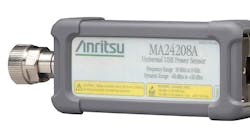This file type includes high resolution graphics and schematics when applicable.
Power measurements are critical for gauging the performance of both wired and wireless RF/microwave systems. On that note, a pair of power sensors developed by Anritsu Co. leverages the flexibility of the Universal Serial Bus (USB) to use personal computers (PCs) as assistants when making power measurements. The two USB power sensors, the 10-MHz-to-8-GHz model MA24208A and the 10-MHz-to-18-GHz model MA24218A, offer high accuracy despite being low cost, and use a patented triple-path architecture to perform true RMS power measurements over a wide dynamic range.
The MA24208A and MA24218A (see figure) provide a dynamic power-measurement range of –60 to +20 dBm across their respective frequency ranges, with level accuracy of ±0.5 dB or better. They suit an assortment of power measurements, including average power measurements of continuous-wave (CW), multiple-tone, and digitally modulated signals independent of the modulation bandwidth.
The compact instruments can be used with their own internal trigger or with an external trigger. Advanced triggering capabilities simplify time-dependent power measurements of signals as found in systems such as Long-Term Evolution (LTE), WiMAX, and Global System for Mobile (GSM) wireless-communications systems. The USB power sensors can also handle production-line testing, with fast measurement speeds for outstanding throughput in production-test applications.
The power sensors perform more than 1600 readings/s for continuous measurements, and more than 11,000 readings/s for buffered measurements. In fact, for true ease in setups and measurements, the USB power sensors deliver accurate test results without need of zeroing for power levels of greater than –45 dBm.
The USB power sensors are protected against damage from “over-zealous” input power levels of as much as +30 dBm for CW signals and up to +34 dBm for pulsed power peaks of less than 10 μs at 10% duty cycle. The portable power sensors will connect to any computer with a USB 2.0 interface and draw power from the bus, with current consumption of about 410 to 450 mA. In addition to the USB port, they’re equipped with Type-N male connectors. The power sensors weigh 397 g (0.88 lb.) and measure 110 × 46 × 25.6 mm excluding the Type-N connector. They’re characterized for accurate measurements over an operating temperature range of 0 to +50°C.
Both sensors are compatible with most of the company’s handheld instruments, including the Site Master cable and antenna analyzer, the Spectrum Master handheld spectrum analyzer, the Cell Master cellular base-station analyzer, and the VNA Master vector network analyzer (VNA).
The MA24208A and MA24218A can be used with any Windows-based PC and operated by means of the PowerXpert analysis and control software from Anritsu. The software contains drivers for the power sensors and applications to speed and simplify power measurements. A straightforward user’s guide is available for free download, with the software, in .pdf file format on the firm’s website.
Anritsu Co., 1155 East Collins Blvd., Ste. 100, Richardson, TX 75081; (800) 267-4878, (972) 644-1777, Fax: (972) 671-1877
This file type includes high resolution graphics and schematics when applicable.


